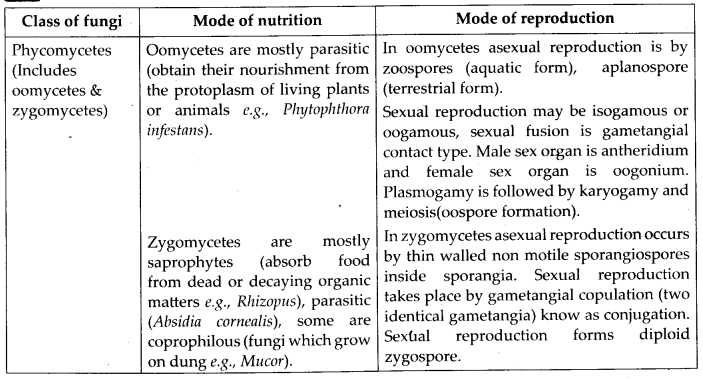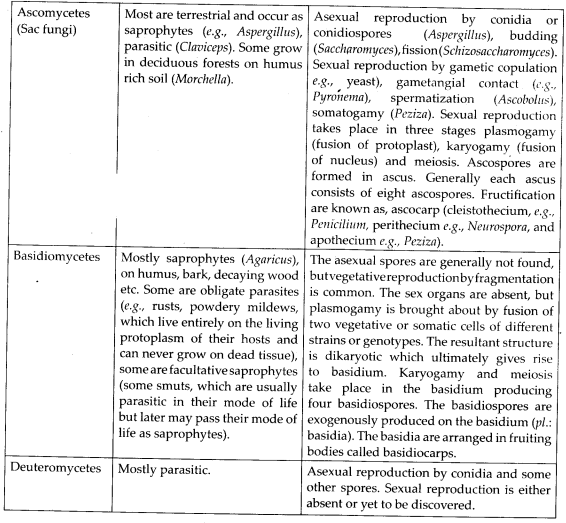Chapter 2 Biological Classification
Class 11th Biology NCERT Book Solution
NCERT Solutions For Class 11 Biology Biological Classification
NCRT TEXT BOOK QUESTIONS SOLVED
1.Discuss how classification
systems have undergone several changes over a period of
time?
Soln. Biological
classification is the scientific procedure of arranging organisms in a
hierarchical series of groups and sub-groups on the basis of their similarities
and dissimilarities. Scientists have proposed different systems of
classification which have undergone several changes from time to time.
Earlier Aristotle proposed artificial system of classification, which divided
animals and plants on basis of habitat. E.g., Aquatic (fish, whale), terrestrial
(e.g., reptiles, cattle) and aerial (e.g., bat, birds). Then, natural system of
classification was based on morphology^ anatomy, physiology, reproduction,
ontogeny, cytochemistry, etc. After natural system, organisms were classified on
basis of evolutionary relationships called phyloge¬netic system. It is based on
cytotaxonomy, chemotaxOnomy, numerical taxonomy and cladistic taxonomy.
2.State two economically
important uses of:
(a) heterotrophic
bacteria
(b)
archaebacteria
Soln. (a) Heterotrophic
bacteria: They include saprotrophic, symbiotic and parasitic bacteria. They act
as natural scavengers as they dispose off the dead bodies, organic wastes,
release raw materials for reutilisation. They also help in sewage disposal,
manure production etc. Symbiotic bacteria help in nitrogen fixation. Some
bacteria arq employed in the production of a number of industrial products like
lactic
acid, curd, cheese, butter, vinegar etc. Some bacteria are used in
preparation of serum, vaccines, vitamins, enzymes, antibiotics etc. e.g.,
Pseudomonas, Xanthomonas, etc.
(b) Archaebacteria : Archaebacteria are
employed in the production of gobar gas from dung and sewage and in ruminants,
they cause fermentation of cellulose.
3.What is the nature of
cell-wall in diatoms?
Soln. The cell walls of
diatoms are called frustules. The cell wall is chiefly composed of cellulose
impregnated with glass-like silica. It is composed of two overlapping halves (or
theca) that fit together like two parts of a soap box or petri dish. The upper
half (lid) is called epitheca and the lower half (case) is called hypotheca. The
outer covering possesses very fine markings, pits, pores and ridges. The
siliceous frustules of diatoms do not decay easily. They pile up at the bottom
of water reservoirs and form big heaps called diatomite or diatomaceous earth.
It may extend for several hundred metres in certain areas from where the same
can be mined.
4.Find out what do the terms
‘algal bloom’ and ‘red tides’ signify.
Soln.The
rapid increase in populations of algae and other phytoplanktons, in particular
cyanobacteria, in water bodies rich in organic matter is called algal bloom. The
density of the organisms may be such that it may prevent light from passing to
lower depths in the water body. Algal blooms are caused by an increase in levels
of nitrate, a mineral ion essential for algal and bacterial growth.
The
source of increased nitrate may be from agricultural fertilizers, which are
leached – into water systems from the land, or sewage effluent.
Red tides are
caused by a sudden, often toxic proliferation of marine phytoplankton, notably
dinoflagellates, that colour the sea red, brown, or yellowish due to the high
concentration of the photosynthetic accessory pigments. Some dinoflagellates,
such as Gonyaulax, produce potent toxins, which may kill fish and invertebrates
outright or accumulate in the food chain, posing a hazard to humans eating
shellfish and other seafood. These phytoplanktonic blooms may be related to
nutrient-rich inputs from the land, or upwelling oceanic waters, and are
initiated by the activation of cyst-like forms lying on the sea bed.
5.How are viroids different
from viruses?
Soln. Viroids are the
smallest known agent of infectious diseases that contain small single-stranded
RNA molecule. They lack capsid and have no proteins associated with them.
Viroids infect only plants. Whereas, viruses have genetic material surrounded by
a protective coat of protein or lipoprotein. The genetic material of viruses are
of 4 types – double-stranded DNA, double-stranded RNA, single-stranded DNA,
single-stranded RNA. They infect both plants and animals.
6.Describe briefly the four
major groups of protozoa.
Soln.
All protozoans are heterotrophs and live as predators or. parasites. They are
be-lieved to be primitive relatives of animals. They are classified into four
groups on the basis of locomotory organelles.
(i) Amoeboid protozoans : These
organisms live in fresh water, sea water or moist soil. They move and capture
their prey by developing pseudopodia (false feet) as in Amoeba. Some of them
such as Entamoeba are parasites.
(ii)Flagellated protozoans : The members of
this group are either free-living or parasitic. They have flagella for
locomotion. The parasitic forms cause diseases such as sleeping sickness e.g.,
Trypanosoma.
(iii)Ciliated protozoans : These are aquatic, actively moving
organisms because of the presence of thousands of cilia. They have
a cavity
(gullet) that opens to the outside ‘
of the cell surface. The coordinated
movement of rows of cilia causes the water laden with food to be steered into
the gullet e.g., Paramecium. ~
(iv)Sporozoans: This includes diverse
parasitic organisms that have an infectious spore¬like stage in their life
cycle. Locomotory organs are absent. The most notorious N . is Plasmodium
(malarial parasite) which
causes malaria which has a staggering effect on
human population.
7.Plants are autotrophic. Can
you think of some
plants that are partially
heterotrophic?
Soln. Some insectivorous
plants like Drosera,
Nepenthes, Utricularia are partially heterotrophic
plant. These plants are deficient in nitrogen
content but are otherwise
autotrophic. They, trap various insects to obtain nitrogen from them. Rest, the
food i.e., carbohydrate is
manufactured by themselves.
8.What do the terms
phycobiont and mycobiont signify?
Soln.
A lichen is structurally organised
entity consisting of the permanent
association
of a fungus and an alga. The fungal component of a lichen is
called mycobiont and the algal component is called phycobiont. Both mycobiont
and phycobiont are associated
in symbiotic union in which the fungus is
predominant and alga is subordinate partner. – ; Fungus provides the structural
covering that protects alga from unfavourable conditions,
i.e., drought,
heat, etc. It also traps moisture from the atmosphere and anchors the
lichen
to a rock, tree bark, leaves and other similar supports. The alga prepares
organic food by the process of photosynthesis from carbon dioxide. If the algal
component is cyanobacteria (blue-green alga), they fix atmospheric nitrogen in
addition to preparation of food.
9.Organise a discussion in
your class on the topic – ‘Are viruses living or
non-living’?
Soln. Viruses are
regarded as intermediate between non-living entities and living
organisms. It
is very difficult to ascertain whether they are living or non-living. Some .
characters of viruses suggest their non-living nature whereas many other
characters suggest their living nature.
They resemble non-living objects in
–
(i) Lacking protoplast.
(ii)Ability to get crystallised.
(iii)Inability to live independent of living cell.
(iv)High specific gravity
which is found
.only in non-living objects.
(v)Absence of respiration.
(vi)Absence of energy storing system.
(vii)Absence of growth and division.
Instead different parts are synthesized separately.
Viruses resemble living
beings in –
(i)Being formed of organic macromolecules which occur only in
living beings.
(ii)Presence of genetic material.
(iii)Ability to multiply
or reproduce although only inside living cell.
(iv)Occurrence of
mutations.
(v) Occurrence of enzyme transcriptase in most viruses.
(vi)Some viruses like Pox virus contains vitamins like riboflavin and
biotin.
(vii)Infectivity and host specificity.
(viii)Viruses are ‘killed’
by autoclaving and ultraviolet rays.
(ix)They breed true to their type. Even
variations are inheritable.
(x) They take over biosynthetic machinery of the
host cell and produce chemicals required for their multiplication.
(xi)Viruses are responsible for a number of infectious’ diseases like common
cold, epidemic influenza, chicken pox.
10.What are the
characteristic features of Euglenoids?
Soln.
The euglenoid flagellates are the most interesting organisms having a mixture of
animal and plant characteristics. The characteristic features are:
(i) They
are unicellular flagellates.
(ii)These protists lack a definite cellulose
cell wall. Instead the cells are covered by
a thin membrane known as
pellicle. The pellicle is composed of protein, lipid and carbohydrates.
(iii)One or two flagella which help these protists in active swimming are
present. If two flagella are present, then one is long and other is short. They
are tinsel – shaped i.e., with two longitudinal rows of fine hairs. Each
flagellum has its own basal granule. The two flagella join with each other at a
swelling, called paraflagellar body and finally only one long flagellum emerges
out through the cytostome.
(iv)Cell at the anterior end possesses an
eccentric mouth or cytostome which leads into a flask-shaped cavity viz. gullet
or cytopharynx. Gullet opens into a large basal reservoir.
(v) At one end of
the reservoir, the cytoplasm contains an orange red stigma (eye spot). The eye
spot is a curved plate with orange-red granules and contains red pigment
astaxanthin. Both paraflagellar body and eye spot act as photoreceptors.
(vi)Just below the reservoir is found a contractile vacuole having many feeding
canals. The contractile vacuole takes part in osmoregulation. It expands and
pumps its fluid contents in the reservoir.
(vii)The mode of nutrition in
euglenoids is holophytic or photoautotrophic. Some euglenoids show mixotrophic
nutrition (both holophytic as well as saprobic mode).
(viii)Cytoplasm is
differentiated into ectoplasm and endoplasm. Nucleus is large and occurs roughly
in middle. The envelope and nucleolus persist during cell division.
(ix)Each
chloroplast is composed of a granular matrix traversed by 10-45 dense bands and
is covered by 3-membraned envelope. They contain the photo¬synthetic
pigments-chlorophyll – n, b. They store carbohydrates as paramylon bodies,
scattered throughout the cytoplasm.
(x) Asexual reproduction occurs by
longitudinal binary fission. The flagellum is duplicated before cell
division.
(xi)Under unfavourable condition the euglenoids form cysts to
perennate the dry period.
(xii)Sexual reproduction is not observed.
11.Give a brief account of
viruses with respect to their structure and nature of genetic material. Also
name four common viral diseases.
Soln.
Virus (L. poisonous fluid) is a group of ultramicroscopic, non-cellular, highly
infectious agents that multiply only intracellularly- inside the living host
cells without involving growth and division. Outside the host cells, they are
inert particles. They are nucleoproteins having one or more nucleic acid
molecule, either DNA or RNA, encased in a protective coat of protein or
lipoprotein. A virus consist of two parts – nucleoid (genome) and capsid. An
envelope and few enzymes are present in some cases,
(i) Nucleoid : The
nucleic acid present in the virus is called nucleoid and it represents viral
chromosome. It is made up of a single molecule of nucleic acid. It may be
linear
or circular and nucleic acid can be DNA or RNA. It is the infective
part of virus which utilizes the metabolic machinery of the host cell for
synthesis and assembly of viral components.
(ii)Capsid : It is a protein
covering around genetic material. Capsid have protein subunits called
capsomeres. Capsid protects nucleoid from damage from physical and chemical
agents. ,
(iii)Envelope : It is the outer loose covering present in certain
viruses like animal viruses (e.g., HIV) but rarely present in plant and
bacterial viruses and made of protein of viral origin and, lipid and
carbohydrate of host. Outgrowths called spikes may be present. Envelope proteins
have subunits called peplomers. A virus without envelope is naked virus.
(iv)Enzymes : Rarely, lysozymes are found in bacteriophages. Reverse
transcriptase enzyme (catalyses RNA to DNA synthesis) is found in some RNA
viruses like HIV. Some common viral diseases are – influenza, polio, measles,
chickenpox, hepatitis, AIDS, bird flu, SARS (Severe Acute Respiratory Syndrome)
etc.
12.Give a comparative account
of the classes of Kingdom Fungi under the following:
(i) mode of nutrition (ii) mode of
reproduction
Soln.
